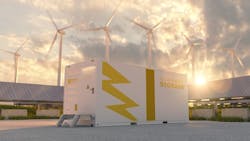Interconnection Jam: Southwest Power Pool Latest to Sound DER Warning
The Southwest Power Pool is feeling overwhelmed by the rising wave of decentralized energy projects such as solar-storage microgrids and seeking some relief from the U.S. Federal Energy Regulatory Commission.
The FERC request highlights a key challenge for the nation’s grid system operators such as Southwest Power Pool (SPP), Mid-Continent ISO, California ISO, PJM and others. The pace of new distributed energy project applications apparently is more than the systems can handle and leading to interconnection delays of up to five years or more.
SPP asked for FERC permission to delay its 2024 interconnection queue cluster study progression and to stop accepting new DER project requests until SPP can get its process under control. DERs would include solar, wind, battery storage, generators and microgrids which might combine some or all of those DER components.
“Good cause exists to grant the requested waiver, as it will enable SPP to focus its limited resources on processing the unprecedented number of interconnection requests already in the queue without delaying the ultimate execution of final generator interconnection agreements (GIAs) for pending or future clusters,” reads the system operator’s request before FERC.
“Despite considerable efforts over the past few years to clear its interconnection queue backlog, SPP continues to experience a dramatically increasing volume of interconnection requests,” the filing reads. The various clusters of DER interconnection clusters include “66 requests totaling 13,592 MW and 108 requests totaling 22,744 MW, respectively.”
Solar energy rises to historic highs in the SPP
The various interconnection request clusters are the largest volume being studied in Southwest Power Pool history, the system operator said.
SPP oversees grid operations from a variety of utilities, generation and transmission systems including North Dakota, South Dakota, Nebraska, Kansas, Missouri, Oklahoma, Arkansas, New Mexico, Montana and parts of Texas, which otherwise is operated by the Electric Reliability Council of Texas.
Most interconnection requests across the SPP system are based primarily on DERs with solar, wind, battery storage and hybrid systems. Some 95 GW of interconnection requests is led by solar with 42 GW in the pipeline, according to the SPP Generation Interconnection Update.
Solar currently makes up only 0.2% of the nameplate generation capacity installed across SPP’s territory, but is exponentially elevating its position with close to 36,323 MW in stages of study and development, the SPP presentation says. Natural gas, utility-scale wind and coal account for 92% of that current resource mix, according to the system operator.
Interconnection woes reverberate across the U.S.
Generator interconnections are a tariff-based service provided by the transmission system operator to facilitate “orderly interconnection of new generation to the grid,” the SPP Generation Interconnection Update says.
To counter arguments that the system operators are impeding DER and on-site power project development, the SPP report said it has added 31 GW of installed capacity into the grid through more than 160 GIAs since January 2017.
An April story in Microgrid Knowledge by Kathy Hitchens noted the recent report from Lawrence Berkeley National Lab confirming that the long interconnection queues are impacting and significantly hampering completion rates for renewable energy infrastructure projects across the U.S.
Close to 90% of the queued capacity nationwide is solar, storage and wind, according to the Berkeley Lab report. These include projects planned to support distributed generation for EV charging infrastructure.
The National Lab indicated only 19% of all projects that requested interconnection between 2000 and 2018 were operational by 2023. This means that only 14% of solar and 11% of battery storage projects survived to the operational stage.
ERCOT recently reported that the volume of battery storage on its Texas grid system had risen to 8 GW installed and could nearly double by the end of 2025.
Battery Storage Charging Ahead in Lone Star State
The U.S. Department of Energy earlier this year released a new Transmission Interconnection Roadmap as a guide for planners, customer, state agencies, regulators, transmission owners, load serving utilities and advocacy groups.
Track News of Microgrids and DERS Across Grid Interconnections
Subscribe to our free Microgrid Newsletter
About the Author
Rod Walton, Microgrid Knowledge Managing Editor
Managing Editor
For Microgrid Knowledge editorial inquiries, please contact Managing Editor Rod Walton at [email protected].
I’ve spent the last 15 years covering the energy industry as a newspaper and trade journalist. I was an energy writer and business editor at the Tulsa World before moving to business-to-business media at PennWell Publishing, which later became Clarion Events, where I covered the electric power industry. I joined Endeavor Business Media in November 2021 to help launch EnergyTech, one of the company’s newest media brands. I joined Microgrid Knowledge in July 2023.
I earned my Bachelors degree in journalism from the University of Oklahoma. My career stops include the Moore American, Bartlesville Examiner-Enterprise, Wagoner Tribune and Tulsa World, all in Oklahoma . I have been married to Laura for the past 33-plus years and we have four children and one adorable granddaughter. We want the energy transition to make their lives better in the future.
Microgrid Knowledge and EnergyTech are focused on the mission critical and large-scale energy users and their sustainability and resiliency goals. These include the commercial and industrial sectors, as well as the military, universities, data centers and microgrids. The C&I sectors together account for close to 30 percent of greenhouse gas emissions in the U.S.
Many large-scale energy users such as Fortune 500 companies, and mission-critical users such as military bases, universities, healthcare facilities, public safety and data centers, shifting their energy priorities to reach net-zero carbon goals within the coming decades. These include plans for renewable energy power purchase agreements, but also on-site resiliency projects such as microgrids, combined heat and power, rooftop solar, energy storage, digitalization and building efficiency upgrades.


